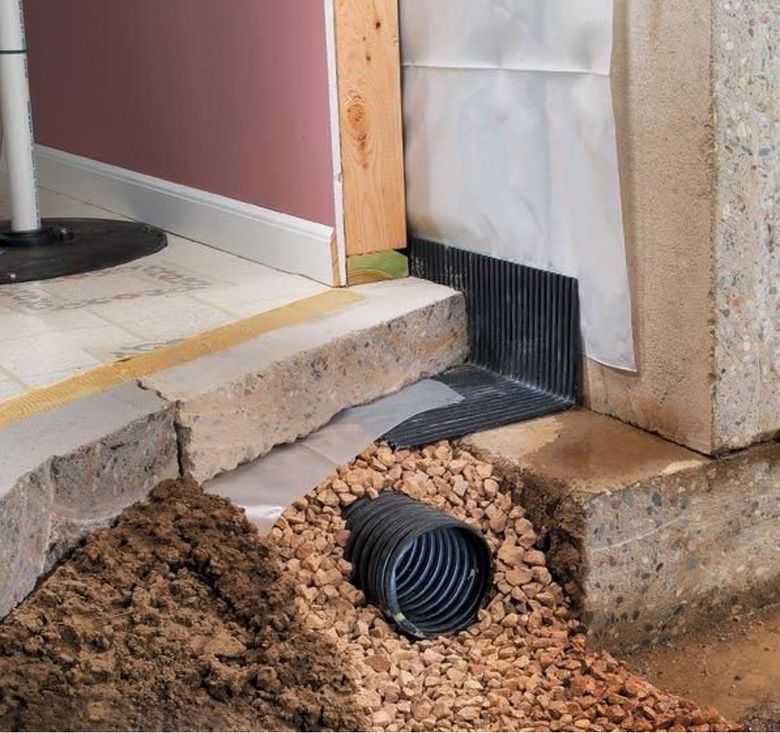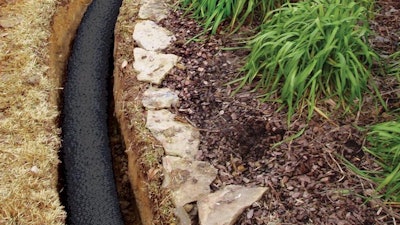Top Perks of Installing a Portland French Drain Around Your Home
Top Perks of Installing a Portland French Drain Around Your Home
Blog Article
How a French Drainpipe Can Assist Prevent Water Damage in Your Basement
If you're handling a moist cellar, a French drainpipe may be the remedy you require. Portland French Drain. This system successfully reroutes water far from your structure, helping to avoid costly damages. Recognizing how it functions and identifying the indicators that you require one can make a considerable distinction in your home's safety and comfort. Prior to you determine, it's essential to explore the benefits and setup process to see if it's the ideal fit for your scenario.
What Is a French Drain?
A French drain is an easy yet reliable solution for handling excess water around your residential or commercial property. It's made to redirect water far from prone locations, like your cellar or foundation. Generally, it includes a trench loaded with gravel and a perforated pipe that gathers and networks water. When rainwater or groundwater accumulates, the drainpipe efficiently guides it away, protecting against prospective damage.You could discover French drains installed along property lines, driveways, and even near your home's foundation. They are available in different dimensions and configurations, making them adaptable to different landscapes and water drainage requirements. Mounting a French drain can aid you avoid expensive repair services and protect your home's architectural stability. If you have actually been managing water merging or soaked areas in your backyard, a French drain might be the remedy you need. It's an aggressive step to assure your residential property continues to be completely dry and risk-free from water-related problems.
How Does a French Drain Job?
A French drainpipe kicks right into action to reroute it successfully when water builds up around your home. This system is composed of a trench filled with crushed rock and a perforated pipeline at the base. The pipeline gathers excess water from the dirt and channels it away from your foundation.As rain or groundwater seeps into the gravel, it flows through the perforations and right into the pipe. Gravity does the job, pulling the water far from your basement and routing it to a designated water drainage area, like a storm drainpipe or dry well.You can set up a French drain either inside or outside your home. It'll stop water from merging near your structure if you select an outside setup. An indoor drain will capture water that permeates through your basement walls. This efficient layout keeps your room completely dry, allowing you to enjoy your home without the worry of water damages.
Advantages of Mounting a French Drain
Installing a French drainpipe can significantly improve your home's strength against water damages. You'll delight in efficient water diversion, which helps in reducing mold and mildew development and shield your property. Plus, a properly maintained drainage system can even enhance your property's value.
Effective Water Diversion

Minimized Mold And Mildew Development
Since wetness produces an excellent setting for mold to thrive, minimizing water accumulation around your home is vital for maintaining a healthy and balanced living room. Setting up a French drainpipe efficiently networks excess water far from your foundation, keeping your cellar dry. This proactive measure significantly reduces moisture degrees, making it harder for mold and mildew spores to clear up and grow.With less dampness, you'll locate it less complicated to take a breath and delight in a tidy, secure environment. Plus, you'll lower the danger of wellness issues connected with mold and mildew exposure, such as allergies and respiratory system troubles. By purchasing a French drainpipe, you're taking a crucial step toward a mold-free cellar, ensuring that your home continues to be a comfy area for you and your household.
Increased Residential Or Commercial Property Value
A French drainpipe can substantially enhance your building's worth, making it a wise financial investment for homeowners. When prospective customers see a properly maintained cellar free from water damage, they're most likely to be satisfied. This attribute not only improves your home's charm however additionally signals that you have actually taken positive steps to secure it. By decreasing the threat of water-related problems, your building ends up being extra eye-catching in an open market, commonly causing higher offers. In addition, the long-term cost savings on fixings and maintenance can convert right into enhanced equity. Installing a French drain shows you respect your home's honesty, guaranteeing customers that they're making an audio purchase. Eventually, it's a useful enhancement that repays in even more ways than one.
Indications You Need a French Drain
It's a clear indication that you might require a French drainpipe if you see relentless water build-up in your backyard or basement. In addition, a stuffy smell can suggest trapped dampness, which can lead to bigger problems. Addressing these indicators early can aid protect against severe water damages to your home.
Persistent Water Accumulation
It's a clear indication that a French drain might be required when you observe persistent water build-up around your home. Water merging near your foundation can result in considerable damage over time, consisting of architectural concerns and mold development. You need to take notice of areas where water seems to accumulate after hefty rainfalls or snowmelt. If your lawn remains soaked for days, it's time to do something about it. Furthermore, search for indicators of disintegration or sloppy spots, as these can show poor drain. Installing a French drainpipe aids reroute water away from your home, safeguarding your foundation and lowering the threat of water damage. Don't wait on bigger concerns to develop-- dealing with water build-up currently can save you costly fixings later on.
Stuffy Smell Presence
Persistent water accumulation often causes even more than just noticeable pooling; it can create an environment ripe for moldy smells. If you notice a damp, stale odor in your cellar, it's an indication that dampness is lingering, often because of inadequate drain. This odor usually indicates about his mold and mildew or mold growth, which can pose health and wellness risks and harm your possessions. You might locate that the smell aggravates during humid climate or after hefty rainfalls. If you're battling persistent moldy odors, it's time to examine a French drainpipe. This system reroutes water away from your structure, reducing moisture levels and combating those undesirable smells. Do not ignore this caution sign; addressing it without delay can save you from extra comprehensive water damages down the line.
The Installment Process of a French Drainpipe
Mounting a French drainpipe can be a simple process that considerably improves your home's water damage avoidance. Assess the area where you desire to mount the drain, guaranteeing it slopes away from your structure. Next off, mark the trench's course, which must have to do with 6-8 inches wide and 18-24 inches deep.Excavate the trench, getting rid of dirt as needed. Portland French Drain. As soon as you have actually got your trench, set landscape fabric to stop dirt from obstructing the drainpipe. Include a layer of gravel at the base. Area a perforated pipe on top of the gravel, making certain the openings encounter downward for reliable drainage.Cover the pipeline with more crushed rock, leaving about 3 inches of room at the top. Fold up the landscape textile over the crushed rock to secure it. Fill in the trench with soil, compacting it as you go. You have actually currently established a trustworthy system to reroute water far from your cellar!
Upkeep Tips for Your French Drainpipe
A French drain is designed to efficiently handle water flow, regular maintenance is necessary to validate its continued efficiency. Beginning by inspecting the drain and its environments for debris or obstructions. Clear any leaves, dust, or debris that could accumulate, especially after heavy rains.Next, check the electrical outlet for appropriate drain. It must guide water away from your foundation-- if it does not, you might require to adjust its position. Furthermore, confirm that the gravel bordering the drain is intact and hasn't settled gradually; this aids preserve correct water flow.Consider arranging an annual professional examination to catch any problems early. If you discover any signs of water damages or merging, resolve them immediately to prevent larger problems down the road. With a little interest, your French drainpipe can successfully shield your basement for years ahead.
Cost Factors To Consider and Long-Term Financial Savings
When taking into consideration a French drainpipe, it's important to weigh both the first investment and the lasting cost savings it can provide. While the ahead of time cost may seem considerable, think regarding it as a financial investment in your home's future. Setting up a French drain typically varies from $1,500 to $5,500, depending on your basement's size and the intricacy of the installation.However, this cost can conserve you thousands in possible water damages, mold and mildew removal, and foundation fixings. By stopping water accumulation, you're likewise protecting your home's worth and avoiding costly insurance policy cases. Furthermore, a completely dry basement can decrease your why not try this out energy bills, as moisture can bring about enhanced cooling and heating prices. Eventually, the tranquility of mind that includes recognizing your home is safeguarded from water damages is valuable. Think about these factors meticulously to make a well-informed choice that profits you over time.

Frequently Asked Questions
Can a French Drainpipe Be Installed in Any Kind Of Dirt?
Yes, a French drainpipe can be set up in various soil types, including clay, sand, and loam. Correct installation and drain planning are important to ensure it operates successfully in your particular dirt conditions.
Just how Lengthy Does a French Drain Last Before Needing Replacement?
A French drainpipe commonly lasts around 30 to 40 years with proper setup and upkeep. Elements like dirt type and water circulation can impact its lifespan, so keep an eye on its performance.
Can French Drains Pipes Help With Backyard Drain Issues?
Yes, French drains pipes can successfully resolve yard drain problems. They direct excess water away from issue locations, preventing merging and guaranteeing your landscape remains healthy and balanced. Mounting one can greatly enhance your yard's general drain efficiency.
Will a French Drainpipe Influence My Landscaping or Garden?
A French drainpipe can impact your landscaping or garden, especially if it's installed incorrectly. You'll wish to make sure it's put tactically to minimize disruption, maintaining your plants and total visual while improving drainage.
Exist Alternatives to French Drainpipes for Basement Water Issues?
Yes, there are options to French drains pipes for basement water concerns. You may take into consideration sump pumps, water-proof finishings, or grading your lawn to reroute water away. Each option has its benefits, so evaluate what fits your needs best. When rainwater or groundwater constructs up, the drain successfully overviews it away, preventing possible damage.You may see French drains pipes mounted along property lines, driveways, or also near your home's foundation. Gravity does the job, drawing the water away from your basement and directing it to a marked drainage area, like a storm drain or completely dry well.You can mount a French a fantastic read drainpipe either inside or outside your home. By efficiently transporting water away from your property, a French drain can significantly decrease the risk of water damage. Mounting a French drainpipe helps redirect water away from your home, securing your foundation and reducing the threat of water damages. Setting up a French drainpipe can be an uncomplicated procedure that considerably improves your home's water damage prevention.
Report this page